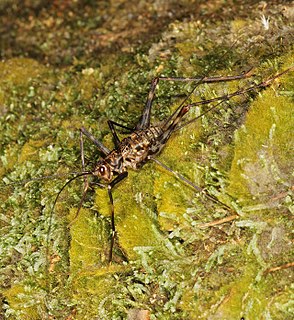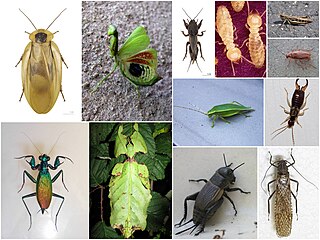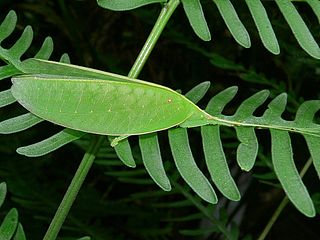
The orthopteran family Rhaphidophoridae of the suborder Ensifera has a worldwide distribution. Common names for these insects include the cave wētā, cave crickets, camelback crickets, camel crickets, spider crickets and sand treaders. Those occurring in New Zealand, Australia, and Tasmania are typically referred to as jumping or cave wētā. Most are found in forest environments or within caves, animal burrows, cellars, under stones, or in wood or similar environments. All species are flightless and nocturnal, usually with long antennae and legs. More than 1100 species of Rhaphidophoridae are described.

The family Gryllidae contains the subfamilies and genera which entomologists now term true crickets. They belong to the Orthopteran subfamily Ensifera, having long, whip-like antennae and has been reduced in terms of the older literature, with taxa such as the spider-crickets and allies, sword-tail crickets, wood or ground crickets and scaly crickets elevated to family level. The type genus is Gryllus and the first use of the family name "Gryllidae" was by Walker.

Mole crickets are members of the insect family Gryllotalpidae, in the order Orthoptera. Mole crickets are cylindrical-bodied insects about 3–5 cm (1.2–2.0 in) long as adults, with small eyes and shovel-like fore limbs highly developed for burrowing. They are present in many parts of the world and where they have arrived in new regions, may become agricultural pests.

Ensifera is a suborder of insects that includes the various types of crickets and their allies including: true crickets, camel crickets, bush crickets or katydids, grigs, weta and Cooloola monsters. This and the suborder Caelifera make up the order Orthoptera. Ensifera is believed to be a more ancient group than Caelifera, with its origins in the Carboniferous period, the split having occurred at the end of the Permian period. Unlike the Caelifera, the Ensifera contain numerous members that are partially carnivorous, feeding on other insects, as well as plants.

Gryllacrididae are a family of non-jumping insects in the suborder Ensifera occurring worldwide, known commonly as leaf-rolling crickets or raspy crickets. The family historically has been broadly defined to include what are presently several other families, such as Stenopelmatidae and Rhaphidophoridae, now considered separate. As presently defined, the family contains two subfamilies: Gryllacridinae and Hyperbaeninae. They are commonly wingless and nocturnal. In the daytime, most species rest in shelters made from folded leaves sewn with silk. Some species use silk to burrow in sand, earth or wood. Raspy crickets evolved the ability to produce silk independently from other insects, but their silk has many convergent features to silkworm silk, being made of long, repetitive proteins with an extended beta-sheet structure.

Acheta is a genus of crickets. It most notably contains the house cricket Acheta domesticus. According to Direction 46 issued by the ICZN in 1956, this generic name is masculine in gender.

Gryllus is a genus of field cricket. Members of the genus are typically 15–31 mm long and darkly coloured. The type species is Gryllus campestris L.: the European field cricket.

Phalangopsinae, occasionally known as spider crickets, are a subfamily of crickets in the family Phalangopsidae. Members of Phalangopsinae are found worldwide in tropical and subtropical regions. Most species in the subfamily are nocturnal and can be found in rocky areas, near fallen wood, and the understory of forests. Some species are gregarious, gathering in large numbers.

The Tridactylidae are a family in the insect order Orthoptera. They are small, mole-cricket-like insects, almost always less than 20 mm (0.79 in) long when mature. Generally they are shiny, dark or black, sometimes variegated or sandy-coloured. They commonly live in short tunnels and are commonly known as pygmy mole crickets, though they are not closely related to the true "mole crickets" (Ensifera), as they are included in the Caelifera suborder.

Brachytrupes is a genus of mostly African crickets in the family Gryllidae.
Scapteriscus borellii, the southern mole cricket, is a species of insect in the family Gryllotalpidae. It is native to South America but is also present in the southern United States where it was introduced around 1900.
Scapteriscus abbreviatus, the short-winged mole cricket, is a species of insect in the mole cricket family, Gryllotalpidae. It is native to South America but has been introduced inadvertently into Florida, in the United States. Unlike other related species, it is unable to fly, nor do the males emit songs in order to attract females.

Lesina is a genus of bush cricket in the tribe Agraeciini. Species in this genus are known as 'dragon headed katydids' with the similar species Ellatodon blanchardi. They are native to tropical Asia including Malaysia, Indonesia and Borneo, while they are endemic to Croatia. They are listed as endangered on the IUCN Red List of Threatened Species due to a continuing decline of mature individuals.

The cohort Polyneoptera is a proposed taxonomic ranking for the Orthoptera and all other Neopteran insects believed to be more closely related to Orthoptera than to any other insect orders. These winged insects, now in the Paraneoptera, were formerly grouped as the Hemimetabola or Exopterygota on the grounds that they have no metamorphosis, the wings gradually developing externally throughout the nymphal stages.

Pseudophyllus is a genus of bush-cricket, found in Indo-China and Malesia. It is the type genus of the tribe Pseudophyllini and the subfamily Pseudophyllinae.

Ripipterygidae is a family of insects in the order Orthoptera. Members of the family are commonly known as mud crickets.

The Phalangopsidae are a recently reconstituted family of crickets, based on the type genus PhalangopsisServille, 1831 from South America. Priority for family-group names based on this genus dates from Blanchard's "Phalangopsites".

Tachycines asynamorus is a cave cricket and the type species of the genus Tachycines (Rhaphidophoridae). In English-speaking countries it is known as the greenhouse camel cricket or greenhouse stone cricket for its propensity for living in greenhouses. It was first described in 1902 by Russian entomologist Nicolai Adelung. Some authorities have placed this species in the genus Diestrammena, but it has now restored to its basonym.

Gryllacris is a genus of Orthopterans, sometimes known as 'leaf-folding crickets' in the family Gryllacridinae. It is the type genus for the family, tribe Gryllacridini and its subfamily.

Tarbinskiellus is a genus of crickets in the family Gryllidae and tribe Gryllini. Species can be found in Asia.






















